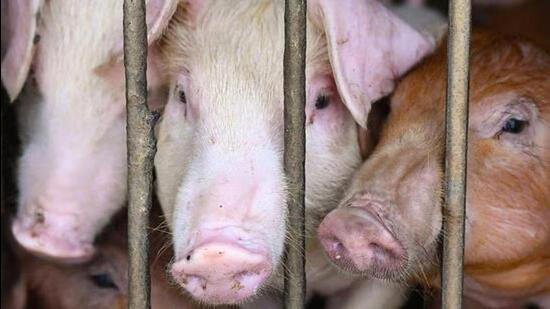Mizoram, April 2025 — A fresh wave of African Swine Fever (ASF) has swept through Mizoram, claiming the lives of more than 1,000 pigs within just one month. This deadly outbreak has not only devastated livestock but has also sent shockwaves through the state’s agrarian economy, particularly affecting the livelihood of small-scale pig farmers.
The Mizoram Animal Husbandry and Veterinary Department confirmed that the resurgence of ASF began in March and rapidly spread across multiple districts, including Aizawl, Champhai, and Lunglei. Authorities reported that 1,039 pigs have succumbed to the disease so far, marking one of the deadliest flare-ups since the first outbreak in 2021.
What is African Swine Fever?
African Swine Fever is a highly contagious and fatal viral disease that affects domestic and wild pigs. Caused by a DNA virus of the Asfarviridae family, ASF has no known cure or vaccine, making prevention and culling the only effective methods of control. While it poses no risk to human health, its high mortality rate and swift transmission have grave implications for pig-rearing communities.
The virus can survive in raw pork, contaminated feed, and even on clothing, making it extremely difficult to contain once it spreads. Unlike swine flu, ASF is not zoonotic, but the economic losses it triggers can be catastrophic.
Epicentres of the Outbreak
The department identified several high-risk zones in Mizoram, with Champhai district bordering Myanmar recording the highest number of pig deaths. Local officials believe the porous international border may have contributed to the resurgence, with pigs or pork products potentially being smuggled across.
“We are working round the clock to contain the spread,” said a senior veterinary officer. “Culling and burial protocols have been intensified, and strict monitoring is underway in affected areas.”
As a part of its containment strategy, the government has set up surveillance checkpoints, imposed temporary bans on the movement of pigs and pork, and launched awareness campaigns to educate farmers about early signs of infection and necessary hygiene practices.
Farmers in Distress
For many in Mizoram, pig farming is not just a source of income but a way of life. The latest outbreak has left farmers emotionally and financially shattered.
“I had 14 pigs, and all of them died in a week. I invested everything in them — from feed to medicine. Now I have nothing,” said Lalhmingmawia, a pig farmer from Aizawl district, while struggling to hold back tears.
The state’s pig population had already been severely impacted during the 2021-22 ASF outbreaks, which killed more than 30,000 pigs and led to the culling of thousands more. Recovery was slow and painstaking. The recurrence now threatens to wipe out the progress made over the past two years.
Economic Implications
Pork is a staple in the Mizo diet and forms a significant part of the local meat market. With the sudden drop in pig numbers and the ban on pork sales in affected regions, prices have skyrocketed, triggering concerns over food inflation.
Moreover, the economic ripple effects extend to feed suppliers, butchers, transporters, and even restaurant owners who rely on pork-based dishes.
The Mizoram government has sought assistance from the central government to compensate affected farmers and bolster its veterinary infrastructure. However, officials admit that without a long-term strategy, outbreaks will likely recur due to the state’s geographical vulnerabilities and high pig population density.
Call for Coordinated Action
Veterinary experts argue that a coordinated effort involving border control, early diagnosis, and community participation is essential to curbing ASF. There have also been calls to invest in research for an ASF vaccine and create pig farming zones with higher biosecurity.
Until then, vigilance remains the only weapon.
The return of African Swine Fever in Mizoram is a stark reminder of the fragile nature of livestock farming in the face of viral epidemics. As over 1,000 pigs lie buried beneath the Mizo soil this month, the people await not just relief and support, but also a more resilient system that can safeguard their livelihoods against future outbreaks.




